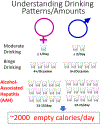Malnutrition and Alcohol-Associated Hepatitis
- PMID: 34229839
- PMCID: PMC8672300
- DOI: 10.1016/j.cld.2021.03.002
Malnutrition and Alcohol-Associated Hepatitis
Abstract
Malnutrition is common in alcohol-associated hepatitis (AH); almost all patients with severe AH have some component of malnutrition. The classic phenotype of malnutrition in AH is sarcopenia, but this has become more difficult to discern clinically as patients have become more obese. Patients with AH are often drinking 10 to 15 standard drinks per day. This substantial alcohol consumption becomes a major source of calories, but these are considered "empty" calories that contain little nutritional value. Malnutrition is associated with liver complications, such as hepatic encephalopathy, and worse liver outcomes. Nutrition support can improve nutrition status and reduce complications.
Keywords: Alcohol-associated hepatitis (AH); Malnutrition; Micronutrients; Nutrition; Standard drink.
Published by Elsevier Inc.
Figures

References
-
- Durand F, Buyse S, Francoz C, et al. Prognostic value of muscle atrophy in cirrhosis using psoas muscle thickness on computed tomography. J Hepatol. 2014;60(6):1151–1157. - PubMed
-
- Pirlich M, Schütz T, Spachos T, et al. Bioelectrical impedance analysis is a useful bedside technique to assess malnutrition in cirrhotic patients with and without ascites. Hepatology. 2000;32(6):1208–1215. - PubMed
-
- Makhija S, Baker J. The Subjective Global Assessment: a review of its use in clinical practice. Nutr Clin Pract. 2008;23(4):405–409. - PubMed
-
- Mendenhall CL, Anderson S, Weesner RE, Goldberg SJ, Crolic KA. Protein-calorie malnutrition associated with alcoholic hepatitis. Veterans Administration Cooperative Study Group on Alcoholic Hepatitis. Am J Med. 1984;76(2):211–222. - PubMed
Publication types
MeSH terms
Grants and funding
LinkOut - more resources
Full Text Sources
Medical

